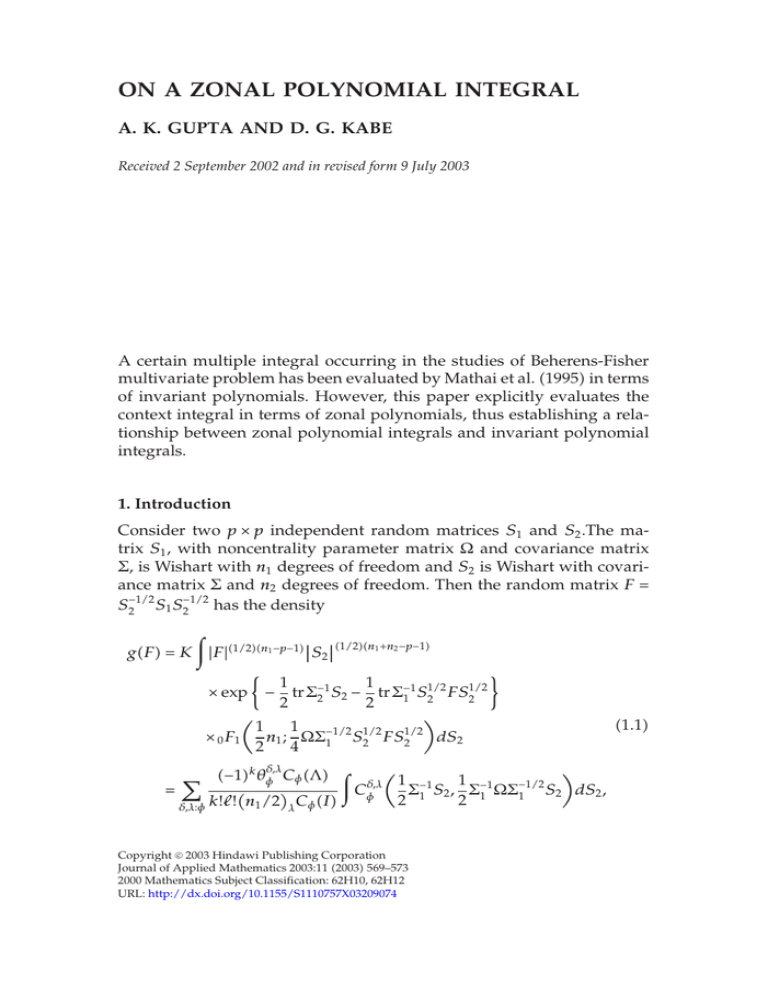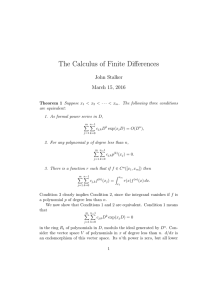ON A ZONAL POLYNOMIAL INTEGRAL
advertisement

ON A ZONAL POLYNOMIAL INTEGRAL
A. K. GUPTA AND D. G. KABE
Received 2 September 2002 and in revised form 9 July 2003
A certain multiple integral occurring in the studies of Beherens-Fisher
multivariate problem has been evaluated by Mathai et al. (1995) in terms
of invariant polynomials. However, this paper explicitly evaluates the
context integral in terms of zonal polynomials, thus establishing a relationship between zonal polynomial integrals and invariant polynomial
integrals.
1. Introduction
Consider two p × p independent random matrices S1 and S2 .The matrix S1 , with noncentrality parameter matrix Ω and covariance matrix
Σ, is Wishart with n1 degrees of freedom and S2 is Wishart with covariance matrix Σ and n2 degrees of freedom. Then the random matrix F =
S1 S−1/2
has the density
S−1/2
2
2
(1/2)(n1 +n2 −p−1)
g(F) = K |F|(1/2)(n1 −p−1) S2 1
1
1/2
−1 1/2
tr
Σ
× exp − tr Σ−1
S
−
S
FS
2
2
1
2
2
2
2
1
1
1/2
1/2
n1 ; ΩΣ−1/2
dS2
S
FS
× 0 F1
1
2
2
2
4
δ,λ
(−1)k θφ Cφ (Λ) δ,λ 1
1 −1
−1/2
Σ−1
Σ
Cφ
=
S
,
ΩΣ
S
2
2 dS2 ,
1
2 1
2 1
δ,λ:φ k!! n1 /2 λ Cφ (I)
Copyright c 2003 Hindawi Publishing Corporation
Journal of Applied Mathematics 2003:11 (2003) 569–573
2000 Mathematics Subject Classification: 62H10, 62H12
URL: http://dx.doi.org/10.1155/S1110757X03209074
(1.1)
570
On a zonal polynomial integral
where Λ is the p × p diagonal matrix of the roots of F and K as a generic
letter denotes the normalizing constants of density functions in this paper.
Mathai et al. [4, equations (5.5.11), (5.5.12), pages 274–275] do not
evaluate the integral (1.1). However, they derive the density of the roots
of F in terms of a series of invariant polynomials of two matrix arguments. This paper explicitly obtains the density of F in terms of zonal
polynomials, a result which has not been available in the literature so
far, not even in terms of invariant polynomials. An expression for the
density of the roots of F is also derived in terms of invariant polynomials of two arguments, which is slightly different from the one presented
by Mathai et al. [4, equation (5.5.11), page 274].
The next section states some useful results and the main results of the
paper are derived in Section 3. Although it is not always possible to derive invariant polynomial results in terms of zonal polynomials, sometimes it is as done in this paper. We assume that all matrices occurring in
this paper are full-rank matrices, except the noncentrality parameter Ω
which may have any rank.
2. Some useful results
If P is any p × p matrix, then it is known that (see Gupta and Nagar
[2])
1 1 n; P P .
K exp{tr P V }|I − V V |(1/2)(n−2p−1) dV = 0 F1
2 4
(2.1)
Now we can write P = (P P )1/2 H for some p × p orthogonal H, see G. A.
Korn and T. M. Korn [3, page 412]. It follows that
K exp{tr QP V }|I − V V |(1/2)(n−2p−1) dV
= K exp tr Q(P P )1/2 HV |I − V V |(1/2)(n−2p−1) dV
= K exp tr(P P )1/2 Q V |I − V V |(1/2)(n−2p−1) dV
= 0 F1
1 1 1 1 n; P P Q Q = 0 F1
n; Q QP P
2 4
2 4
= K exp{tr P QV }|I − V V |(1/2)(n−2p−1) dV.
(2.2)
A. K. Gupta and D. G. Kabe
571
Again it follows from (2.2) that
K exp tr Q(P P )1/2 HV |I − V V |(1/2)(n−2p−1) dV
= K exp tr H (P P )1/2 Q |I − V V |(1/2)(n−2p−1) dV
(2.3)
1/2 1/2 (1/2)(n−2p−1)
= K exp tr H (P P )
(Q Q) R |I − V V |
dV
1 1 1
= 0 F1
n; R Q QRH P P H = 0 F1
n; Q QP P ,
2 4
2
where R(p × p) and H(p × p) are any two arbitrary orthogonal matrices
which may depend on Q Q and P P , respectively.
Now it follows from (2.3) that
0 F1
1 1 n; P P Q QT T
2 4
= 0 F1
1 1 n; H P P HR Q QRU T T U ,
2 4
(2.4)
where H, R, and U are any p × p orthogonal matrices, and note that
0 F1
1 1
1 1
n; ABC = 0 F1
n; ∆ ,
2 4
2 4
(2.5)
where ∆ is any permutation of ABC and also holds for any permutation
of four symmetric matrices.
Obviously, (2.4) in terms of zonal polynomials yields
Cθ (Q QP P T T ) = Cθ (R Q QRH P P HU T T U).
(2.6)
From (2.6), note that
exp{tr P P Q QR R} = 0 F1 exp{tr ∆} =
∞
1
t=0
t!
Cθ (P P Q QR R),
(2.7)
where ∆ is any permutation of P P Q QR R. Further, it is easy to verify
that
1 1 1 1 n;
P
n;
P
F
P
Q
QT
T
G
G
=
F
P
Q
QG
GT
T
(2.8)
0 1
0 1
2 4
2 4
because (2.8) is true for any permutation of the four distinct matrices in
(2.8).
Now we proceed with the main result.
572
On a zonal polynomial integral
3. Main results
In view of (2.4), (2.5), and (2.7) and using (1.1), the density of F is given
by
g(F) = K|F|(1/2)(n1 −p−1)
1
1
−1/2
−1/2
−1
× exp − tr Σ2 S − tr Σ1 FΣ1 S |S|(1/2)(n1 +n2 −p−1)
2
2
1
1
−1/2 1/2
1/2
dS
n1 ; Σ−1/2
× 0 F1
ΩΣ
F
SF
1
2
4 1
−(1/2)(n1 +n2 )
−1/2
−1/2 = K|F|(1/2)(n1 −p−1) Σ−1
+
Σ
FΣ
2
1
1
1
1
n1 + n2 , n1 ;
× 1 F1
(3.1)
2
2
−1
1 1/2 −1/2
−1/2
F Σ1 ΩΣ−1/2
F 1/2 Σ−1
FΣ−1/2
2 + Σ1
1
1
2
−(1/2)(n1 +n2 )
(1/2)(n1 −p−1) −1
Σ2 + Σ−1/2
FΣ−1/2
= K|F|
1
1
1/2
1
1
1
−1/2
n1 + n2 , n1 ; Σ−1/2
× 1 F1
ΩΣ
1
2
2
2 1
1/2 −1 −1/2
−1/2
−1/2
−1/2
−1
Σ2 + Σ1 FΣ1
.
× F Σ1 ΩΣ
−1 1/2
Now if Σ1/2
1 Σ2 Σ1 = θI for any scalar θ, then note that
g(F) = K|F|(1/2)(n1 −p−1) |θI + F|−(1/2)(n1 +n2 )
1
1
1
−1
.
n1 + n2 , n1 ; ΩF(θI + F)
× 1 F1
2
2
2
(3.2)
Thus the density of Λ = diag(λ1 , . . . , λp ) of the roots of F is
g(Λ) = K|Λ|(1/2)(n1 −p−1) |θI + Λ|−(1/2)(n1 +n2 )
× 1 F1
i<j
λi − λj
1
1
1
n1 + n2 , n1 ; ΩΛ(θI + Λ)−1 .
2
2
2
(3.3)
The expression is not very suitable for obtaining the density of Λ for
the expression (3.1). For some Q (p × p) orthogonal, let QFQ be still
denoted by F, let L be the p × p diagonal matrix of the roots of Σ1/2 ΩΣ1/2 ,
−1 1/2
and let ∆ be the diagonal matrix of the roots of Σ1/2
1 Σ2 Σ1 . Then the
A. K. Gupta and D. G. Kabe
573
density of this F is
g(F) = K|F|(1/2)(n1 −p−1) |∆ + F|−(1/2)(n1 +n2 )
1
1
1
−1
.
n1 + n2 , n1 ; LF(∆ + F)
× 1 F1
2
2
2
(3.4)
Mathai et al. [4, equation (A.3.5), page 338] showed that
δ,λ −1
(a)φ Cφ − ∆ F, LF
−1
|∆ + F| 1 F1 a, u; LF(∆ + F)
=
.
kK!!(u)λ
δ,λ;φ
−a
(3.5)
We have observed earlier that Cθ (Q QP P ) = Cθ (R Q QRH P P H) and
thus the invariant polynomial argument for matrices can also be replaced
by their roots. Thus the density of Λ for (3.4) is
λi − λj
g(Λ) = K|Λ|(1/2)(n1 −p−1)
i<j
δ,λ (1/2) n1 + n2 φ Cφ − ∆−1 Λ, LΛ
×
.
k!! (1/2)n1 λ
δ,λ;φ
(3.6)
However, (3.6) is not suitable for obtaining the density of (tr F).
Acknowledgment
The authors are thankful to the referee for a critical reading of the paper.
References
[1]
[2]
[3]
[4]
Y. Chikuse, Distributions of some matrix variates and latent roots in multivariate
Behrens-Fisher discriminant analysis, Ann. Statist. 9 (1981), no. 2, 401–407.
A. K. Gupta and D. K. Nagar, Matrix Variate Distributions, Chapman &
Hall/CRC Monographs and Surveys in Pure and Applied Mathematics,
vol. 104, Chapman & Hall/CRC, Boca Raton, Fla, USA, 2000.
G. A. Korn and T. M. Korn, Mathematical Handbook for Scientists and Engineers,
McGraw-Hill, New York, 1961.
A. M. Mathai, S. B. Provost, and T. Hayakawa, Bilinear Forms and Zonal Polynomials, Lecture Notes in Statistics, vol. 102, Springer-Verlag, New York,
1995.
A. K. Gupta: Department of Mathematics and Statistics, Bowling Green State
University, Bowling Green, OH 43403-0221, USA
E-mail address: gupta@bgnet.bgsu.edu
D. G. Kabe: Department of Mathematics and Computer Science, Saint Mary’s
University, Halefax, Nova Scotia, Canada B3H 3C3






